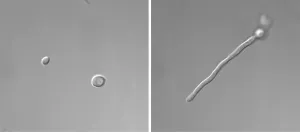(Press-News.org) The field of photonics aims to transform all manner of electronic devices by storing and transmitting information in the form of light, rather than electricity. Beyond light's raw speed, the way that information can be layered in its various physical properties makes devices like photonic computers and communication systems tantalizing prospects.
Before such devices can go from theory to reality, however, engineers must find ways of making their light sources -- lasers -- smaller, stronger and more stable. Robots and autonomous vehicles that use LiDAR for optical sensing and ranging, manufacturing and material processing techniques that use lasers, and many other applications are also continually pushing the field of photonics for higher power and more efficient laser sources.
Now, a team of researchers from the University of Pennsylvania's School of Engineering and Applied Science have drawn from concepts at the edge of theoretical physics to design and build two-dimensional arrays of closely packed microlasers that have the stability of a single microlaser but can collectively achieve power density orders of magnitude higher.
They have now published a study demonstrating their supersymmetric microlaser array in the journal Science.
The study was led by Liang Feng, associate professor in the Departments of Materials Science and Engineering and Electrical and Systems Engineering, along with Xingdu Qiao, Bikashkali Midya and Zihe Gao, members of his lab. They collaborated with fellow Feng lab members Zhifeng Zhang, Haoqi Zhao, Tianwei Wu and Jieun Yim as well as Ritesh Agarwal, professor in the Department of Materials Science and Engineering. Natalia M. Litchinitser, professor of Electrical and Computer Engineering at Duke University, also contributed to the research.
In order to preserve the information manipulated by a photonic device, its lasers must be exceptionally stable and coherent. So-called "single-mode" lasers eliminate noisy variations within their beams and improve their coherence, but as a result, are dimmer and less powerful than lasers that contain multiple simultaneous modes.
"One seemingly straightforward method to achieve a high-power, single-mode laser," Feng says, "is to couple multiple identical single-mode lasers together to form a laser array. Intuitively, this laser array would have an enhanced emission power, but because of the nature of complexity associated with a coupled system, it will also have multiple 'supermodes.' Unfortunately, the competition between modes makes the laser array less coherent."
Coupling two lasers produces two supermodes, but that number increases quadratically as lasers are arrayed in the two-dimensional grids eyed for photonic sensing and LiDAR applications.
"Single mode operation is critical," Qiao says, "because the radiance and brightness of the laser array increase with number of lasers only if they are all phase-locked into a single supermode."
"Inspired by the concept of supersymmetry from physics," he says, "we can achieve this kind of phase-locked single-mode lasing in a laser array by adding a dissipative 'superpartner.'"
In particle physics, supersymmetry is the theory that all elementary particles of the two main classes, bosons and fermions, have a yet undiscovered "superpartner" in the other class. The mathematical tools that predict the properties of each particle's hypothetical superpartner can also be applied to the properties of lasers.
Compared to elementary particles, fabricating a single microlaser's superpartner is relatively simple. The complexity lies in adapting supersymmetry's mathematical transformations to produce an entire superpartner array that has the correct energy levels to cancel out all but the desired single mode of the original.
Prior to Feng and his colleagues' work, superpartner laser arrays could only have been one-dimensional, with each of the laser elements aligned in a row. By solving the mathematical relationships that govern the directions in which the individual elements couple to one another, their new study demonstrates an array with five rows and five columns of microlasers.
"When the lossy supersymmetric partner array and the original laser array are coupled together," Gao says, "all of the supermodes except for the fundamental mode are dissipated, resulting in single-mode lasing with 25 times the power and more than 100 times the power density of the original array. We envision a much more dramatic power scaling by applying our generic scheme for a much larger array even in three dimensions. The engineering behind is the same."
The researchers' study also shows that their technique is compatible with their earlier research on vortex lasers, which can precisely control orbital angular momentum, or how a laser beam spirals around its axis of travel. The ability to manipulate this property of light could enable photonic systems encoded at even higher densities than previously imagined.
"Single-mode, high-power lasing is used in a wide range of important applications, including optical communications, optical sensing and LIDAR ranging," says James Joseph, program manager, Army Research Office, an element of the U.S. Army Combat Capabilities Development Command's Army Research Laboratory, which supported this study. "The research results out of Penn mark a significant step towards creating more efficient and fieldable laser sources."
INFORMATION:
The research was supported by the U.S. Army Research Office under grants W911NF- 19-1-0249 and W911NF-18-1-0348, the National Science Foundation (NSF) under grants ECCS-1932803, ECCS-1842612, and OMA-1936276 and a Sloan Research Fellowship. It was also partially supported by NSF through the University of Pennsylvania Materials Research Science and Engineering Center under grant DMR-1720530 and carried out in part at the Singh Center for Nanotechnology, which is supported by the NSF National Nanotechnology Coordinated Infrastructure Program under grant NNCI-1542153.
Bikashkali Midya is now an assistant professor of Physics at the Indian Institute of Science Education and Research, Berhampur.
Scientists are certain that dark matter exists. Yet, after more than 50 years of searching, they still have no direct evidence for the mysterious substance.
University of Delaware's Swati Singh is among a small group of researchers across the dark matter community that have begun to wonder if they are looking for the right type of dark matter.
"What if dark matter is much lighter than what traditional particle physics experiments are looking for?" said Singh, an assistant professor of electrical and computer engineering at UD.
Now, Singh, Jack Manley, a UD doctoral student, and collaborators at ...
BUFFALO, N.Y. -- You might call Candida albicans a shape-shifter: As this fungus grows, it can multiply as single, oval-shaped cells called yeast or propagate in an elongated form called hypha, consisting of thread-like filaments.
This dual nature can help the pathogen survive in the body, where it can cause disease, including dangerous hospital-acquired infections.
But how does this switching ability occur?
New research identifies one factor that may contribute. In a study that will be published on May 5 in the journal mSphere, University at Buffalo biologists Guolei Zhao and Laura Rusche report that a protein called Sir2 may facilitate C. albicans' transition from ovoid yeast ...
WHAT:
A team of researchers funded by the National Institutes of Health has developed a new ultrasound technique to monitor the placenta for impaired fetal blood flow early in pregnancy. The technique, which uses conventional ultrasound equipment, relies on subtle differences in the pulsation of fetal blood through the arteries at the fetal and placental ends of the umbilical cord, potentially enabling physicians to identify placental abnormalities that impair fetal blood flow and, if necessary, deliver the fetus early. Like current ultrasound techniques, the new technique can also detect impaired flow of maternal blood through the placenta.
The study was conducted by John G. Sled, Ph.D., of The Hospital for Sick Children in Toronto, ...
Magnetic Resonance Imaging (MRI) images are usually meant to be static. But now, researchers from Mātai Medical Research Institute (Mātai), Stevens Institute of Technology, Stanford University, the University of Auckland and other institutions, report on an imaging technique that captures the brain in motion in real time, in 3D and in stunning detail, providing a potential diagnostic tool for detecting difficult-to-spot conditions such as obstructive brain disorders and aneurysms - before they become life threatening.
The new technique, called 3D amplified ...
The ant came in a small vial of ethanol, sealed in a plastic bag, and packed in a small cardboard box. It was addressed to Yale's Douglas B. Booher.
German entomologist Phillip Hoenle had discovered the ant, which he noted had some peculiar features, in a rain forest in Ecuador. Now he wanted Booher, a research associate in the Yale Center for Biodiversity and Global Change and the Department of Ecology & Evolutionary Biology, to confirm whether this trap ant was truly a new species. If so, Hoenle and Booher would have the honor of naming it.
Booher had imagined ...
BIRMINGHAM, Ala. - Last year, Charles O. Elson, M.D., demonstrated a potential preventive treatment for Crohn's disease, a form of inflammatory bowel disease. He used a mouse model that included immune-reactive T cells from patients with Crohn's disease in a flagellin peptide-specific immunotherapy. This study provided proof-of-principle that a flagellin-directed immunotherapy might provide similar benefits in patients.
Now University of Alabama at Birmingham researchers have moved a step closer to possible clinical testing of this treatment, say Elson and co-first authors Katie Alexander, Ph.D., ...
Researchers have created a probe that glows when it detects an enzyme associated with issues that can lead to blood clots and strokes.
The team of researchers, from the Department of Chemistry and the National Lung and Heart Institute at Imperial College London, demonstrated that their probe quickly and accurately detects the enzyme in modified E. Coli cells.
They are now expanding this proof-of-concept study, published in the Journal of the American Chemical Society and funded by the British Heart Foundation (BHF), with the hope of creating rapid tests for cardiovascular problems and a new way to track long-term conditions.
The build-up of plaque in the arteries - known as atherosclerosis - can lead to coronary artery ...
Biodiversity is of crucial importance to the marine ecosystem. The prohibition of trawling activities in the Hong Kong marine environment for two and a half years has significantly improved biodiversity, an inter-university study led by City University of Hong Kong (CityU) has found. Research results showed that the trawl ban could restore and conserve biodiversity in tropical coastal waters.
The research team was led by Professor Kenneth Leung Mei-yee, CityU's Director of the State Key Laboratory of Marine Pollution (SKLMP) and Chair Professor in the Department ...
Researchers at CRANN (The Centre for Research on Adaptive Nanostructures and Nanodevices), and the School of Physics at Trinity College Dublin, today announced that a magnetic material developed at the Centre demonstrates the fastest magnetic switching ever recorded.
The team used femtosecond laser systems in the Photonics Research Laboratory at CRANN to switch and then re-switch the magnetic orientation of their material in trillionths of a second, six times faster than the previous record, and a hundred times faster than the clock speed of a personal computer.
This discovery demonstrates the potential of the material for a new generation of energy efficient ultra-fast computers and data storage systems.
The researchers ...
Despite being home to the earliest signs of modern human behaviour, early evidence of burials in Africa are scarce and often ambiguous. Therefore, little is known about the origin and development of mortuary practices in the continent of our species' birth. A child buried at the mouth of the Panga ya Saidi cave site 78,000 years ago is changing that, revealing how Middle Stone Age populations interacted with the dead.
Panga ya Saidi has been an important site for human origins research since excavations began in 2010 as part of a long-term partnership between archaeologists from the Max Planck Institute for the Science of Human ...







